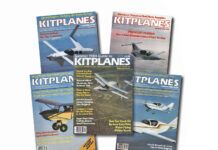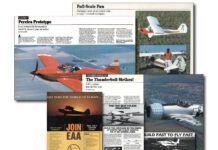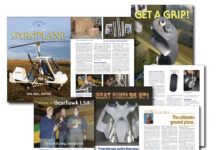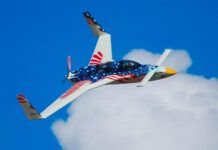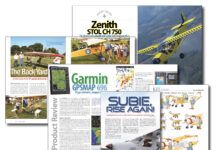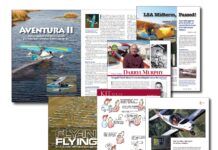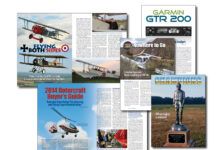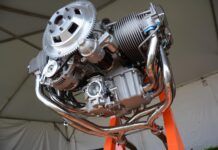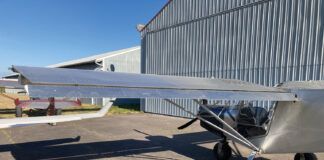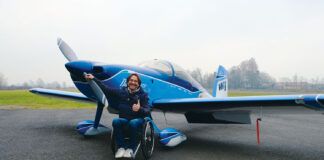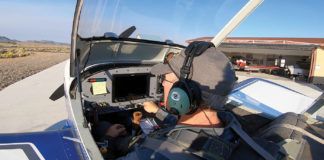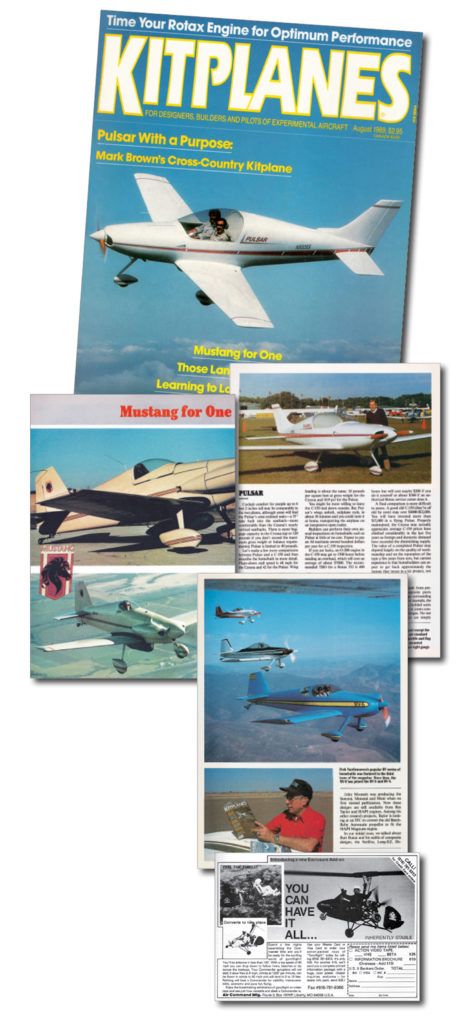 We called it “Pulsar With a Purpose,” on our August 1989 cover, and it was Mark Brown’s popular follow-on to the single-seat Star-Lite, the two-place Pulsar. The factory airplane, N500SS, was powered by a Rotax 532 and would run 125 mph true on 3.8 gph of auto fuel.
We called it “Pulsar With a Purpose,” on our August 1989 cover, and it was Mark Brown’s popular follow-on to the single-seat Star-Lite, the two-place Pulsar. The factory airplane, N500SS, was powered by a Rotax 532 and would run 125 mph true on 3.8 gph of auto fuel.
“A major objective for Brown as he designed the Pulsar was cost-effectiveness in a two-seat, composite airplane,” editor Dave
Martin said in this issue. “A Pulsar kit costs $14,900 plus crating and shipping. The buyer gets all the parts to build the airframe plus VFR instruments, a Rotax 532 65-hp engine, fixed-pitch Peery propeller, wheels, wheel pants and heel brakes.” Brown was a stickler for simplicity and low weight, so the Pulsar had a fiberglass-reinforced spruce main spar and wood wing skins to go with its composite fuselage and simple, forward-sliding canopy. Martin summed it up: “The airplane flies nicely. Control is sensitive but certainly not twitchy. Roll is smooth with little need for rudder to compensate for adverse yaw.” Mark Brown would go on to build an even larger Pulsar, called the XP, with a choice of Rotax 582 or the radically new (for the early 1990s) 912 four-stroke. The Pulsar design was taken over by the SkyStar company and then reformed as Pulsar Aircraft under Rich Trickel, of Tri-R fame.
LeRoy Cook had a review of Jerry Vaughan’s Bushby Midget Mustang. “The single-place, all-metal speedster is quite capable of turning heads today, some 40 years after its inception. Bushby developed a side-by-side two-seat version in 1966 by simply widening the center section and raising horsepower [but] as a pure performance machine, the single-seat version remains most popular.”
Inside, James Cline was noted for having passed 1000 flight hours in his first-generation Glasair. “My wife, Audrey, and I finished our plane and flew it for the first time on August 24, 1984. We spent two years building it, pretty much full time. We turned over 1000 hours on it during a Christmas trip to California last December. [It] has been a real joy to fly,” he summed up.
We noted that Paul Poberezny had left the EAA after 36 years at the helm and that a new president would be elected by the EAA membership. Paul and wife Audrey had nominated their son, Tom, to take over, which he did. Tom would stay in the job for 20 years, after which a tumultuous couple of years under Rod Hightower delivered us to the current CEO, Jack Pelton.
Somewhat hidden in this issue was a birthday celebration of sorts—we had turned five. “A fifth anniversary usually calls for a gift of wood…[or] silverware. No silver airplanes, but we do have plenty of them made out of wood,” Don Downie said in the feature. We recounted the tremendous variety of activity in the field, noting such designs as the Spencer Air Car and the all-metal airplanes doing well from some guy named Richard VanGrunsven. “As seen from a 1989 perspective, KITPLANES® expects to remain where the action is for the foreseeable future.” Interesting that in 1989 we were already looking to the future, like we are this issue, and that some 32 years later, we’re still here.


